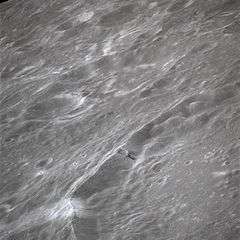Apollo 20 hoax
The Apollo 20 hoax is a hoax perpetrated by a series of YouTube videos which purported that an American and Russian crewed lunar mission discovered evidence of an extraterrestrial civilization on the far side of the Moon.
Premise
In April 2007, videos began appearing on YouTube under the username "retiredafb" claiming that Apollo 20, a secret lunar mission, found evidence of the existence of intelligent, alien life on the Moon.[1] Then, on May 23, 2007, Italian ufologist Luca Scantanburlo interviewed a man who identified himself as William Rutledge, a retired American astronaut living in Rwanda. Rutledge claimed to be the commander of the Apollo 20 crew and to be the owner of the "retiredafb" account. However, Scantanburlo never met Rutledge in person because he conducted the interview over Yahoo! Messenger.[2]

During the interview, Rutledge claimed Apollo 20 was a top-secret mission launched in mid-August 1976 from Vandenberg Air Force Base in Lompoc, California, conducted jointly by the United States and the former Soviet Union. He alleged the other mission members were American Leona Snyder (an apparently fictitious person) and former Soviet cosmonaut Alexei Leonov, the first human being to perform a spacewalk. The purported landing site of the mission was near Guyot crater, a feature near the much larger Delporte crater. Rutledge said the videos show that he and Leonov discovered the remains of an ancient lunar civilization.[3][4] He also said they brought back artifacts to Earth for study, including a hibernating, female humanoid.
The originator of the hoax was French videographer Thierry Speth.[5]
Factual basis

Like many hoaxes, this story is a mixture of facts and fiction. The starting point for it are photos that NASA astronauts took in 1971 while in lunar orbit during the Apollo 15 mission, the fourth mission that landed men on the Moon. The photos show what look like a cigar-shaped object resting in a lunar crater. The hoaxer apparently used these photos to create the image of a pock-marked alien spacecraft on the Moon. The NASA photos are real.[6] However, NASA never claimed they include images of alien spacecraft. The object in question is apparently nothing more than a natural part of the lunar terrain. Apollo 16 photos of the same crater taken a year later show no evidence of artificial structures.
In truth, Apollo 20 was a mission that never flew. It was one of the three lunar missions NASA cancelled after Congress reduced its funding, including Apollo missions 18 and 19. The last crewed lunar mission was Apollo 17, launched in 1972. The next crewed mission that used an Apollo spacecraft was Skylab 2, launched on 25 May 1973, followed by Skylab 3 and Skylab 4 (Skylab 1 was an uncrewed mission that launched the Skylab space station into Earth orbit). The Skylab missions were followed by the Apollo-Soyuz Test Project, coordinated by the United States and the former Soviet Union in 1975.
Some of the stages for the Saturn V rockets intended for NASA's three cancelled lunar missions had already been constructed before their cancellation. According to the hoaxer's story, these were all used for the lunar landings of Apollo missions 18, 19, and 20. In reality, NASA used one of these to launch Skylab into orbit in 1973. The others are on display at three American space centers: the John F. Kennedy Space Center near Cape Canaveral, Florida; the Johnson Space Center in Houston, Texas; and the United States Space & Rocket Center in Huntsville, Alabama.
In popular culture
The Apollo 20 hoax was discussed on Aliens on the Moon: The Truth Exposed, a TV documentary directed by American television producer Robert Kiviat which was released on July 20, 2014 on the SyFy Channel.[7]
See also
References
- retiredafb – via YouTube.
- Scantamburlo, Luca (May 2007). "An Alien Spaceship on the Moon: Interview With William Rutledge, member of the Apollo 20 Crew". Retrieved January 8, 2019.
- Re: APOLLO 20 ALIEN SPACESHIP ON THE MOON CSM FLYOVER 8. 28 July 2007 – via YouTube.
- Re: APOLLO 20 ALIEN SPACESHIP ON THE MOON CSM FLYOVER 2. 8 July 2007 – via YouTube.
- Mary-Ann Russon. "World UFO Day: Alien Girl and the Secret Apollo 20 Mission". International Business Times UK.
- "Apollo Image Atlas".
- Alan Boyle. "'Aliens on the Moon' TV Show Adds Weird UFO Twists to Apollo Tales". NBC News.